AMD Kaveri Review: A8-7600 and A10-7850K Tested
by Ian Cutress & Rahul Garg on January 14, 2014 8:00 AM ESTIntegrated GPU Performance: Sleeping Dogs
Sleeping Dogs is a benchmarking wet dream – a highly complex benchmark that can bring the toughest setup and high resolutions down into single figures. Having an extreme SSAO setting can do that, but at the right settings Sleeping Dogs is highly playable and enjoyable. We run the basic benchmark program laid out in the Adrenaline benchmark tool, and their three default settings of Performance (1280x1024, Low), Quality (1680x1050, Medium/High) and Xtreme (1920x1080, Maximum) noting down the average frame rates and the minimum frame rates.
Sleeping Dogs, Performance Settings
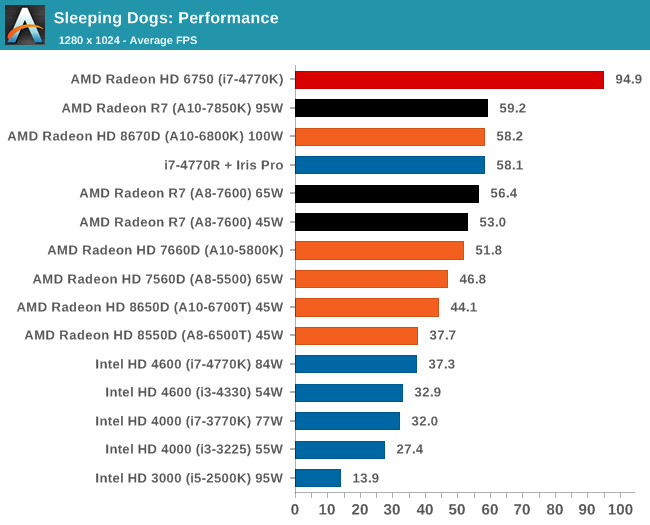
All the AMD APUs tested for this review manage to go above 30 FPS for Sleeping Dogs, with the top end APU nudging at the door of 60 FPS average.
Sleeping Dogs, Quality Settings
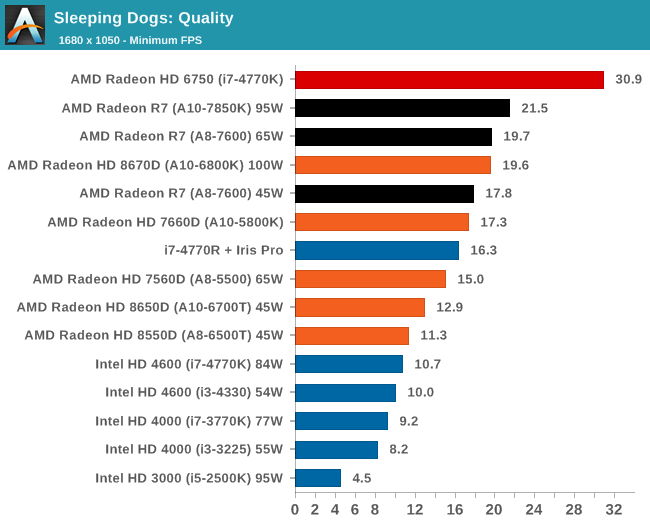
The GCN based Kaveri take the top two IGP spots, and Iris Pro is moving down the list by comparison.
Sleeping Dogs, Xtreme Settings

Iris Pro struggles a lot at 1080p in Sleeping Dogs.
Integrated GPU Performance: Company of Heroes 2
The final gaming benchmark is another humdinger. Company of Heroes 2 also can bring the house down, even at very basic benchmark settings. To get an average 30 FPS at any settings using integrated graphics is a challenge, let alone a minimum frame rate of 30 FPS. For this benchmark I use modified versions of Ryan’s batch files more suited for integrated graphics: 1280x1024 on minimum; 1680x1050 on Low and 1920x1080 on Medium.
Company of Heroes 2, Performance Settings
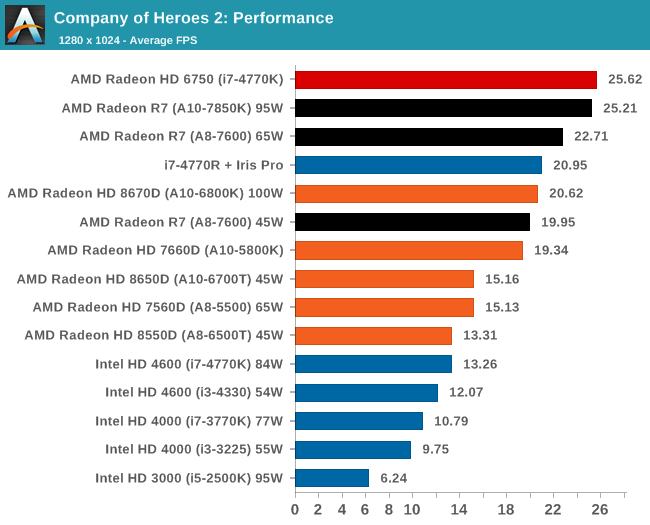
COH2 is demanding enough that even at 1280x1024 and low settings, no platform we tested today can hit 30 FPS average. The 95W Kaveri part does however outshine Richland by almost 25%.
Company of Heroes 2, Quality Settings
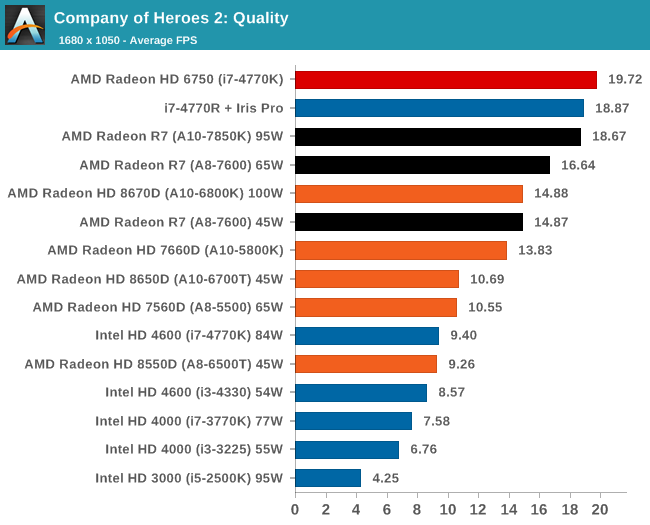
Company of Heroes 2, Xtreme Settings
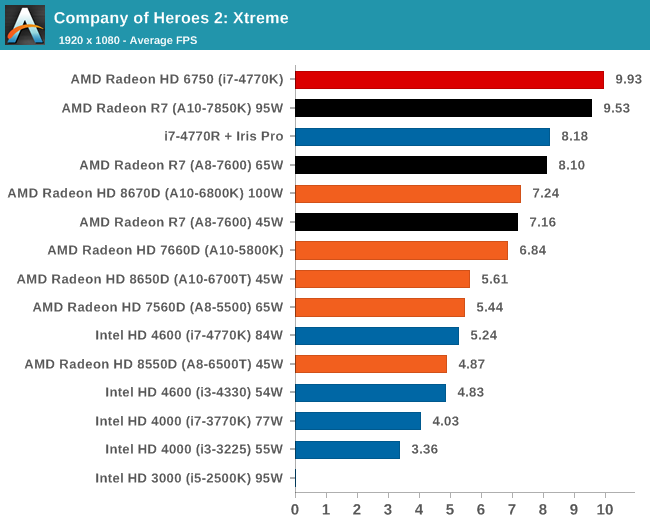
With COH2 extreme settings, the Intel solutions are moving up the minimum FPS ranks to beat AMD.










380 Comments
View All Comments
jaydee - Tuesday, January 14, 2014 - link
I just don't "get" adding three $300 Intel CPU's to a review of 3 sub $200 AMD CPU's. We all know, or can find out how i7 SB, IB, Haswell compare to each other. I can see adding one of these CPUs to show a baseline of how AMDs top-of-the-line compares against Intels (albiet at very different price points), but having all three of them gives the impression that you want to make sure everyone knows who's boss...Is there going to be an update on power draw? I'm really curious to see what the 45W Kaveri draws (idle and full power) considering it is so competitive with the 95W Kaveri.
jaydee - Tuesday, January 14, 2014 - link
I stand corrected, four $300+ Intel i7 CPUs in this comparison, not three. And two Intel CPU's that are actually in the price range of the AMDs. It feels as if to do this review, AT just cobbled together whatever was laying around instead of being intentional about putting together the best test bench possible to compare the review product against its real competitors.It's really a shame, because the commentary, the in-depth look at the architecture and the conclusions are outstanding; no website out there has tech writers as good and do as thorough of a job as Anandtech. The fact that the test benches are just after-thoughts in some of these reviews are really disappointing.
UtilityMax - Tuesday, January 14, 2014 - link
I think this was mentioned somewhere in the beginning of the review. Intel likes to have the i7 reviewed instead of other parts, so the send the i7 CPUs to everyone. This is kind of like what the car makers do. Most people just buy a reasonably priced, mid-spec car model. However, the journos always get to review these ridiculously over-optioned cars, that hardly sell, like the $35 Ford Fusions, even though the base car sells for 10 grand less.jaydee - Tuesday, January 14, 2014 - link
I am well aware that when having the choice, Intel would rather you review a $340 Intel CPU against a $179 AMD CPU. But is there not any way, given the ad revenue of Anandtech, to obtain a $190-200 mid-range Intel i5 CPU (such as the i5-4440) in order to have a relevant test bench for an eagerly anticipated AMD mid-range CPU launch?srkelley - Tuesday, January 14, 2014 - link
"...do any AnandTech readers have an interest in an even higher end APU with substantially more graphics horsepower?"Yes, oh yes! I'm letting the APU be the core of my system build in a few months and plan to upgrade as needed. I'd like a simple solution like an APU instead of having to go with a discrete card right away. If it lets me spend more on ram and other things, keep the psu and power draw low I'm happy. The most demanding game that I play right now is the Witcher 2. Eventually I will have to go discrete for Star Citizen and the Witcher 3 but if I can get solid enough results with a high powered apu then I'll simply jump to that instead.
Conduit - Tuesday, January 14, 2014 - link
This has been a long time coming thanks to Always Major Delays (AMD). Even know they can't get their sh!t together.nissangtr786 - Tuesday, January 14, 2014 - link
http://techreport.com/review/25908/amd-a8-7600-kav...The fpu still not improved miles still behind intel.
http://browser.primatelabs.com/geekbench3/326781
http://browser.primatelabs.com/geekbench3/321256
A5 - Tuesday, January 14, 2014 - link
"do any AnandTech readers have an interest in an even higher end APU with substantially more graphics horsepower? "Maybe in the context of a Steam Machine? But for my main gaming PC, no way. Maybe something they can try out after the next die shrink if SteamOS really takes off.
Xajel - Tuesday, January 14, 2014 - link
I believe the main reason for AMD to not have a new FX is SOI process.. it was okay in it's glory days, but it can't keep it up with bulk silicon...They want to increase the clock at least but they're trapped with 32nm SOI, and why not moving toward 28nm or lower SOI because I think that AMD is already working to convert it's entire CPU's to Bulk Silicon, so it's not logical to make a new design for still not ready yet 28nm or lower SOI while they are already designing the new core for bulk silicon.. knowing that both SOI and bulk require a complete redesign of the silicon just to convert from one to another... so it's not even logical to convert Pilediver or maybe even Steamroller to bulk silicon for only one year while they're working on the next architecture which will be Bulk Silicon...
jimjamjamie - Thursday, January 16, 2014 - link
That makes sense, I was very confused as to why AMD were not going to refresh the FX line - even if HSA is the future for AMD, I presumed new FX sales throughout this year would have helped things along.Perhaps it wasn't worth the cost, but at the same time AMD could really do with keeping the fanboys on side.